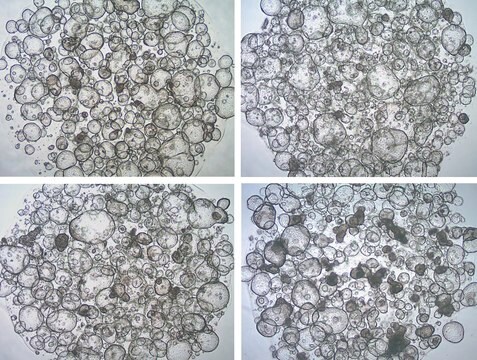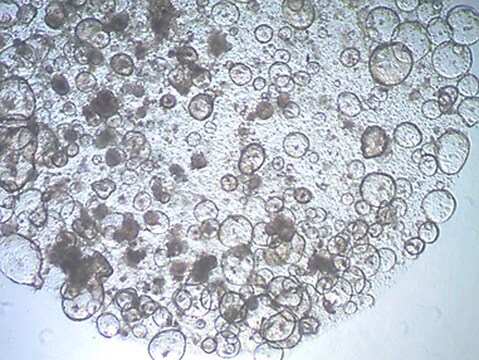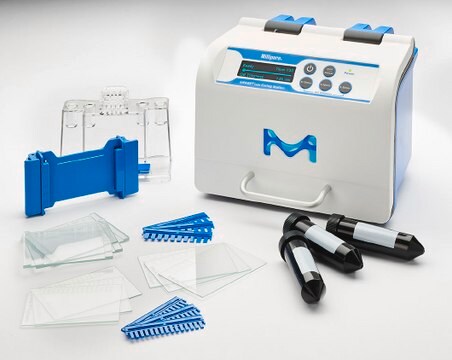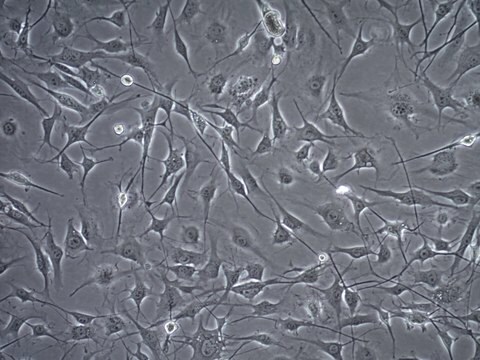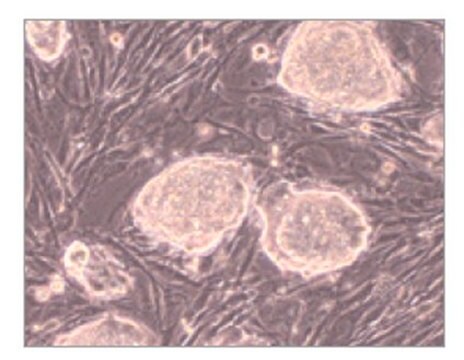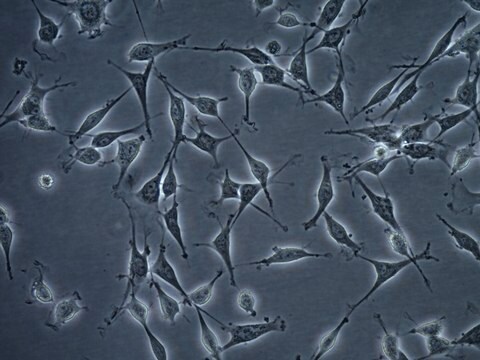SCC445
OSUMMER.1 Mouse NRAS-Mutant Melanoma Cell Line
Iniciar sesiónpara Ver la Fijación de precios por contrato y de la organización
About This Item
Código UNSPSC:
41106514
Productos recomendados
envase
vial of ≥1X10⁶ cells/vial mg
Nivel de calidad
fabricante / nombre comercial
Millipore
modo de crecimiento
N/A
técnicas
cell analysis: suitable
Condiciones de envío
liquid nitrogen
temp. de almacenamiento
−196°C
Aplicación
Each vial contains 1X106 viable cells.
Cells are tested negative for infectious diseases by a Mouse Essential CLEAR Panel by Charles River Animal Diagnostic Services.
Cells are verified to be of mouse origin and negative for inter-species contamination from rat, human, chinese hamster, Golden Syrian hamster, and Non-human Primate (NHP) as assessed by a Contamination Clear panel by Charles River Animal Diagnostic Services
Cells are negative for mycoplasma contamination.
Cells are tested negative for infectious diseases by a Mouse Essential CLEAR Panel by Charles River Animal Diagnostic Services.
Cells are verified to be of mouse origin and negative for inter-species contamination from rat, human, chinese hamster, Golden Syrian hamster, and Non-human Primate (NHP) as assessed by a Contamination Clear panel by Charles River Animal Diagnostic Services
Cells are negative for mycoplasma contamination.
Early-stage melanoma can be cured by resection, but fewer treatment options are available for patients with metastatic disease. Development of resistance to targeted and immunotherapies, as well as toxicity are major problems. Along with sun exposure, sporadic genetic mutations have been associated with melanomas (1). Immunotherapy treatments targeting these genes or pathways have been proven to have significant benefits in melanoma patients by improving general response and survival.
The OSUMMER (Ohio State University and Moffitt Melanoma Exposed to Radiation) cell lines fill a previously unfilled gap in melanoma biology. The OSUMMER cell lines are syngeneic to C57BL/6 laboratory mice and have genetic profiles that are similar to human tumors, making them responsive to immunotherapy treatments. These NRAS-Mutant cell lines can be used to discover and address potential immunotherapies in NRAS-mutant human melanomas which make up an estimated 15-25% of human melanomas. These cell lines also enable in vivo testing of immunotherapies with a mouse model.
OSUMMER.1 mouse NRAS-mutant melanoma cell line was derived from a male TN mouse exposed to UVA and UVB radiation. OSUMMER.1 carries the specific NRAS mutation Q61R and can form tumors in vivo without Matrigel injection. WES revealed high SNV (Single Nucleotide variants) and low CNA (Copy Number Alterations) burden, as well as the presence of UV signature mutations. OSUMMER.1 cells express the melanoma markers PMEL and demonstrate robust growth in culture.
Source
OSUMMER.1 was derived from melanoma induced in TN (Tyr::CreER) mice exposed to UVA or UVB radiation on postnatal day 3 (2).
References
1. Lancet 2018, 392(10151): 971-984.
2. Life Sci Alliance 2021, 4(9): e202101135.
The OSUMMER (Ohio State University and Moffitt Melanoma Exposed to Radiation) cell lines fill a previously unfilled gap in melanoma biology. The OSUMMER cell lines are syngeneic to C57BL/6 laboratory mice and have genetic profiles that are similar to human tumors, making them responsive to immunotherapy treatments. These NRAS-Mutant cell lines can be used to discover and address potential immunotherapies in NRAS-mutant human melanomas which make up an estimated 15-25% of human melanomas. These cell lines also enable in vivo testing of immunotherapies with a mouse model.
OSUMMER.1 mouse NRAS-mutant melanoma cell line was derived from a male TN mouse exposed to UVA and UVB radiation. OSUMMER.1 carries the specific NRAS mutation Q61R and can form tumors in vivo without Matrigel injection. WES revealed high SNV (Single Nucleotide variants) and low CNA (Copy Number Alterations) burden, as well as the presence of UV signature mutations. OSUMMER.1 cells express the melanoma markers PMEL and demonstrate robust growth in culture.
Source
OSUMMER.1 was derived from melanoma induced in TN (Tyr::CreER) mice exposed to UVA or UVB radiation on postnatal day 3 (2).
References
1. Lancet 2018, 392(10151): 971-984.
2. Life Sci Alliance 2021, 4(9): e202101135.
Características y beneficios
The OSUMMER.1 cell line carries the specific NRAS mutation Q61R and may be used to create syngeneic mouse melanoma models.
Almacenamiento y estabilidad
The cells should be stored in liquid nitrogen. The cells can be cultured for at least 10 passages after initial thawing without significantly affecting the cell marker expression and functionality.
Otras notas
This product is intended for sale and sold solely to academic institutions for internal academic research use per the terms of the “Academic Use Agreement” as detailed in the product documentation. For information regarding any other use, please contact licensing@emdmillipore.com.
Cláusula de descargo de responsabilidad
Unless otherwise stated in our catalog or other company documentation accompanying the product(s), our products are intended for research use only and are not to be used for any other purpose, which includes but is not limited to, unauthorized commercial uses, in vitro diagnostic uses, ex vivo or in vivo therapeutic uses or any type of consumption or application to humans or animals.
Producto relacionado
Referencia del producto
Descripción
Precios
Código de clase de almacenamiento
10 - Combustible liquids
Clase de riesgo para el agua (WGK)
WGK 2
Punto de inflamabilidad (°F)
Not applicable
Punto de inflamabilidad (°C)
Not applicable
Certificados de análisis (COA)
Busque Certificados de análisis (COA) introduciendo el número de lote del producto. Los números de lote se encuentran en la etiqueta del producto después de las palabras «Lot» o «Batch»
¿Ya tiene este producto?
Encuentre la documentación para los productos que ha comprado recientemente en la Biblioteca de documentos.
Nuestro equipo de científicos tiene experiencia en todas las áreas de investigación: Ciencias de la vida, Ciencia de los materiales, Síntesis química, Cromatografía, Analítica y muchas otras.
Póngase en contacto con el Servicio técnico